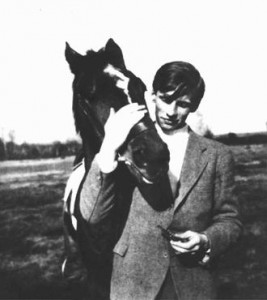
Alexander Schmorell, who was a member of the anti-Nazi student resistance group known as the White Rose, has been canonized by the Russian Orthodox Church Abroad.
Schmorell was of German nationality but Russian ancestry. Deeply religious, he had strong artistic and literary interests–his favorite author was Dostoyevsky—and was studying to be physician. He met Hans Scholl in 1940, and in mid-1942 collaborated with him on the initial White Rose leaflets. Later that year he served as a combat medic on the Eastern Front, and what he saw there reinforced his already-strong anti-Nazi convictions.
Following the arrest of the Scholls and Christoph Probst, Schmorell attempted to escape to Switzerland, but was betrayed by someone he thought was a friend, a woman named Marie-Luise: “Alex’s picture and description had been all over the place by now, and she felt that she had no choice but to report him, if not to save her own neck, but to save her unborn baby’s,” according to the post at the above link.
Shurik, as he was known to his friends, identified strongly with Russia and with Russians:
I love Russia’s endless steppes and breadth, the forest and mountains, over which man has no dominion. I love Russians, everything Russian, which cannot be taken away, without which a person simply isn’t the same. Their hearts and souls, which are impossible to grasp with the mind, which can only be guessed at and sensed, which is their treasure, a treasure that can never be taken away.
Alexander Schmorell was executed by the Nazi state in July 1943. Shortly before he went to the guillotine, he asked his lawyer to tell Marie-Luise that he had forgiven her completely.
A moving description of the canonization ceremony here.
See also my previous post about the White Rose.
David, thank you for this post. I did not know about it.
Here is more about the canonization by the Russian Orthodox Church Outside of Russian (ROCOR).
There are at least two good movies about the White Rose. The 1982 film, titled simply “The White Rose,” is wonderfully done. It shows the group not as plaster saints but as lively, life-loving, sometimes silly kids, who nonetheless felt strong the pull of conscience that led them to take extreme risks. All the performances are good; Oliver Siebert portrays Schmorell in a very appealing way. Unfortunately, this film with the English subtitles was never released on DVD, although a German-only DVD version is apparently available. You can get the subtitled version on VHS, though, and I strongly recommend it.
The more recent film, “Sophie Scholl: the Final Days” is also very good; it is focused particularly on Sophie’s interrogation by the Gestapo, based partly on the actual transcripts of the interrogations.
I saw “Sophie Scholl: the Final Days,” which was very good. The depiction of Roland Fiesler was especially good. Fiesler was killed by a bomb from a Bomber Command Lancaster. A noose after the war would have been better, but dead is dead and Fiesler needed killin’. I’d like to see the other film as well.
A name that frequently appears in articles about the White Rose is that of Lilo Ramdohr. I just googled her and found that she survived the Nazi years and now lives near Munich.
“Lilo” is short for “Liselotte.” Already a widow at the age of 29 following her husband’s death on the Russian front, Liselotte Furst-Ramdohr was introduced to the White Rose group by her friend, Alexander Schmorell. She hid leaflets in her apartment, and also helped Schmorrel make “Down with Hitler” stencils. She was arrested and spent a month in Gestapo custody but was released without being charged. After the war she opened a puppet theater and taught dancing up to the age of 86.
About the canonization of Alexander Schmorell, she said: “He would have laughed out loud if he’d known. He wasn’t a saint – he was just a normal person.”
Article with pictures here.
She certainly has a sense of perspective.
Surely when Furst-Ramdohr referred to Schmorell as “just a normal person,” she meant “normal” in the sense of not being pompous, having a sense of humor, not always being on his best behavior…ie, the things that someone might stereotypically associate with the word “saint.” Clearly, in terms of courage and conscience, he was far from normal…as she says in the same interview, he group couldn’t understand how the German people had been so easily led into supporting the Nazi Party and its ideology.